Pictures of Different Breeds of Geese
Everyone agrees that geese are loud and make good homestead guardians. Learn more about some of the different breeds of geese and their intriguing characteristics.
Breeds of Geese
Like cats, dogs, horses, and chickens, geese come in many different shapes, sizes, and temperaments. While a goose's behavior can be greatly shaped by how it is raised, each breed has distinct traits. Selecting the right breed for your farm will help you be sure you'll get the most from your bird. Some breeds are loud, excellent guardians and not suited to an urban farm. Others are docile, perfect for families with children, and some are showy, with crowd-pleasing feather patterns.
You can get farmyard mix geese from local farms, which have uncertain heritage and are often all gray or white and gray. Mixed stock farmyard birds like this can make the perfect family pet, but if you have any intentions of breeding or showing geese, it is important to start with strong, purebred stock. After researching your options, select breeds that will suit your type of farm and are predisposed to behavior you think you can handle.
African and Chinese Geese
History
Most domesticated geese trace their lineage back to a common ancestor, the Greylag Goose (Anser anser), but this is not the case for the distinctive African and Chinese geese. These birds have Asiatic heritage and descend from the wild Swan Goose (Anser cygnoides), a breed still found in northern China and southern Russia. The actual continental origins of these two geographically named breeds are uncertain, but it is thought that they are called African and Chinese simply because they were introduced to Europe by those who had traveled to exotic locales.
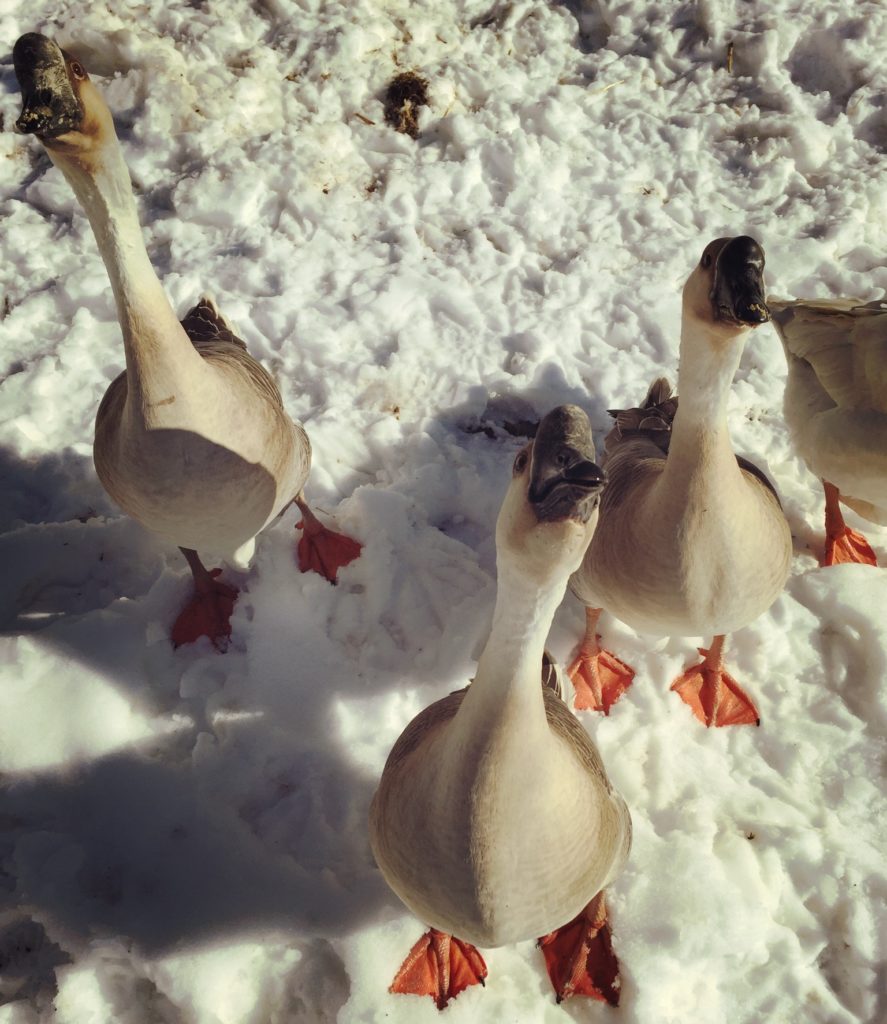
Trio of African geese.
Elegant and graceful, both the African and Chinese geese were introduced to the American Poultry Association's Standard of Perfection in 1874. Since that time, different color variations have emerged, and the apparent distinctions between the two breeds have grown more clear. Always popular on the homestead, both breeds are known for their versatility as egg layers and meat birds, but they are most prized for their particularly loud voices and weeding abilities.
Appearance
What's the difference between African and Chinese geese? Their size. African geese are bigger, weighing up to 20 pounds, while the more petites Chinese geese average only 10 pounds. Both are most commonly found in the brown variety, with black bills, pink feet, and cream underbelly. White Chinese geese are solid white birds with orange bills and feet. For that matter, there is a white variety of African geese, but they are highly unusual.
The most distinctive feature of these Asiatic origin geese is the large knob at the top of their bills. This fleshy bulb is solid and proud, and while its evolution is unknown, a prominent knob is now a sign of well-bred African or Chinese geese. The only disadvantage of this remarkable characteristic is that it can be prone to frostbite.
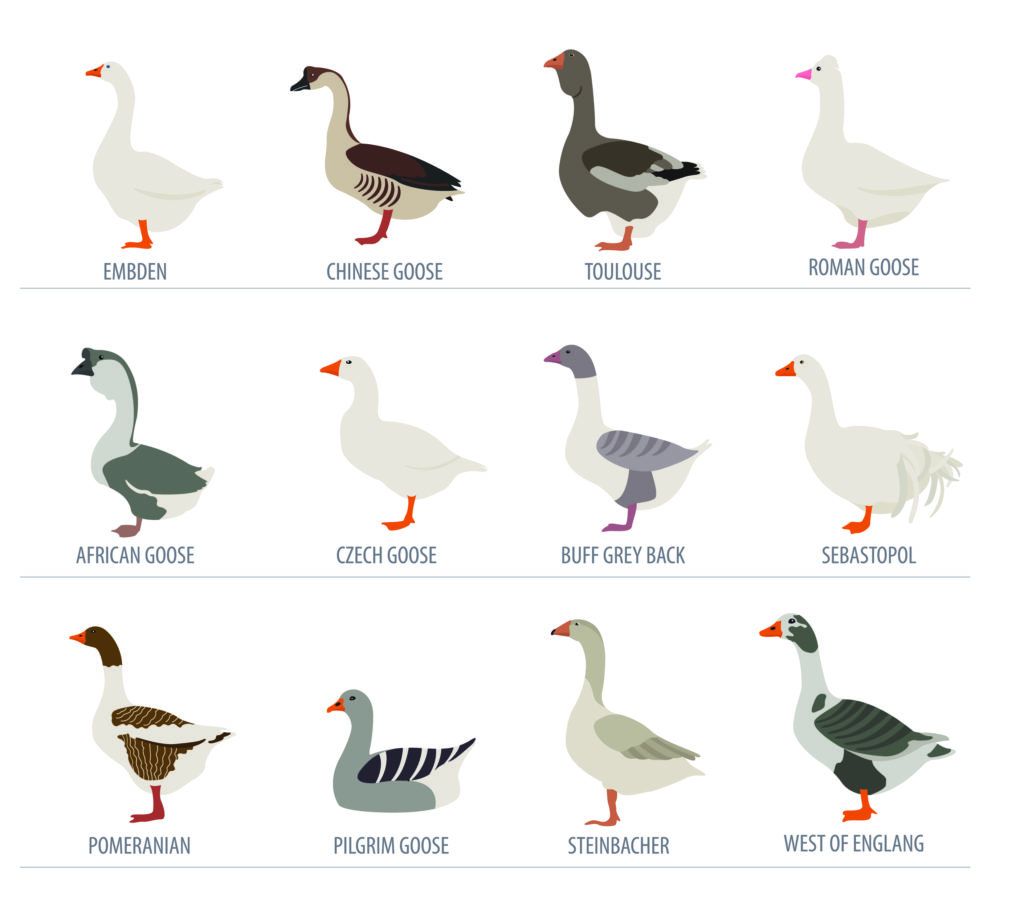
Both birds have a pronounced upright carriage and long, slender necks. African geese should have a fleshy dewlap under their chins and a noticeable full abdomen. They are keelless, having no large deposit of flesh in the chest area, and carry their tails in a rigid, upright manner. Chinese geese are more slender, with longer necks that make them perfect for weeding. With erect tails, no keel, and a tighter abdomen than their heavier, African cousin, the Chinese variety have a lithe appearance of well-conditioned athletes.
Temperament
Chinese geese are the variety most commonly used for weeding tasks. They are high-energy, making them excellent foragers, and their long necks are able to reach in and pluck their favorite weeks from hard to reach spaces.
Both African and Chinese geese are known to be quite vocal. They make excellent guard animals, sounding an alarm at any new activity on the farm, and their piercing vocalizations can be heard across the barnyard. They also tend towards aggression, though hand-raised birds remain friendly. African geese can be more laid back, but they are still known for their loud voices.
Sebastopol Geese
History
There is not another goose with more distinct feathering than the Sebastopol. Its ragged, unkempt look could not be mistaken for any other breed, and they created quite a stir when first introduced to European poultry fanciers in 1860. While the exact origins of the Sebastopol, also called Danubian geese, are unknown, they are though to have originated in the Black Sea region. Known in German asLockengens or "curl gooses," the Sebastopol has remained a popular exhibit bird that continues to impress farmers around the world.
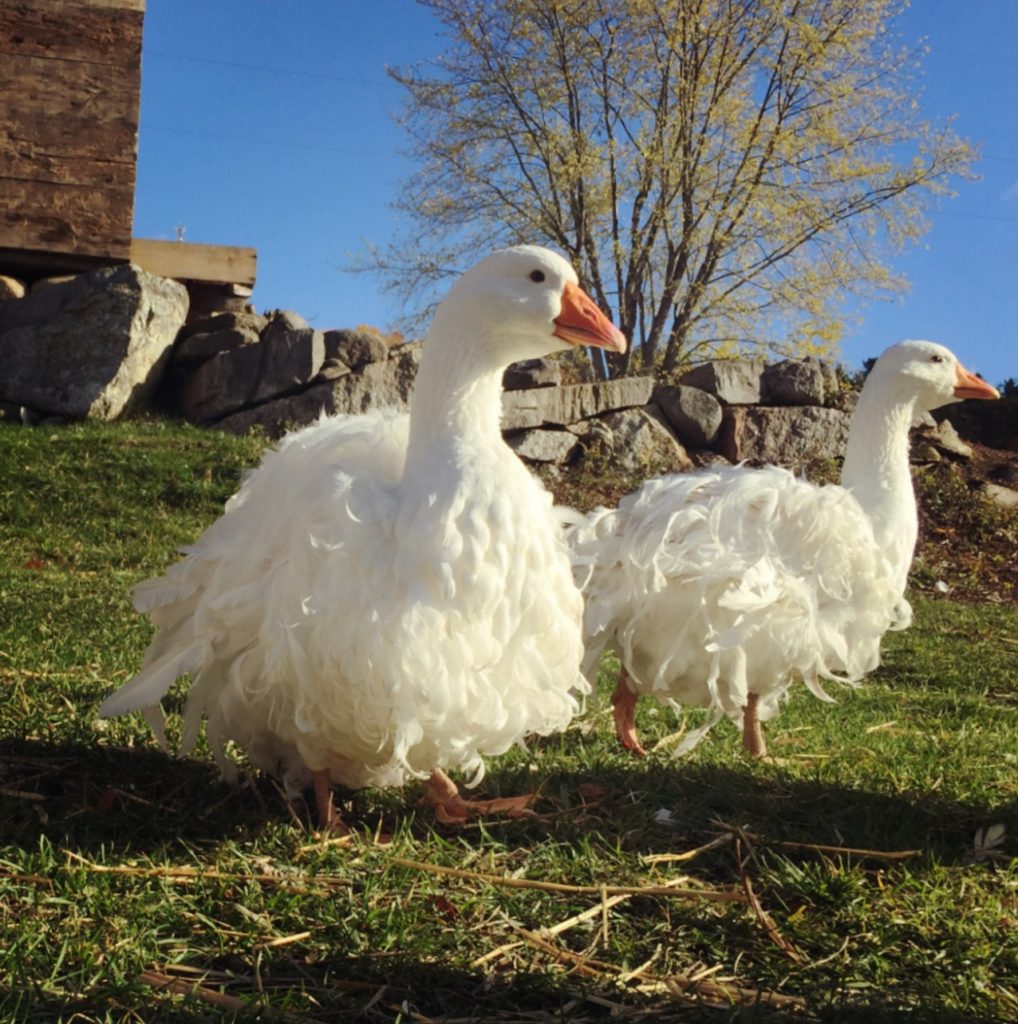
A pair of Sebastopol geese.
Appearance
The feathers of Sevastopol geese have uniquely soft quills that allow them to bend and curl. Their check and back feathers are soft and light. These small birds only grow to 10 pounds. Their bright blue eyes are deep and thoughtful, and their beaks and feet are bright orange. Seb astepols are not as cold hardy as other geese, requiring a warm space out of the wind to avoid a chill.
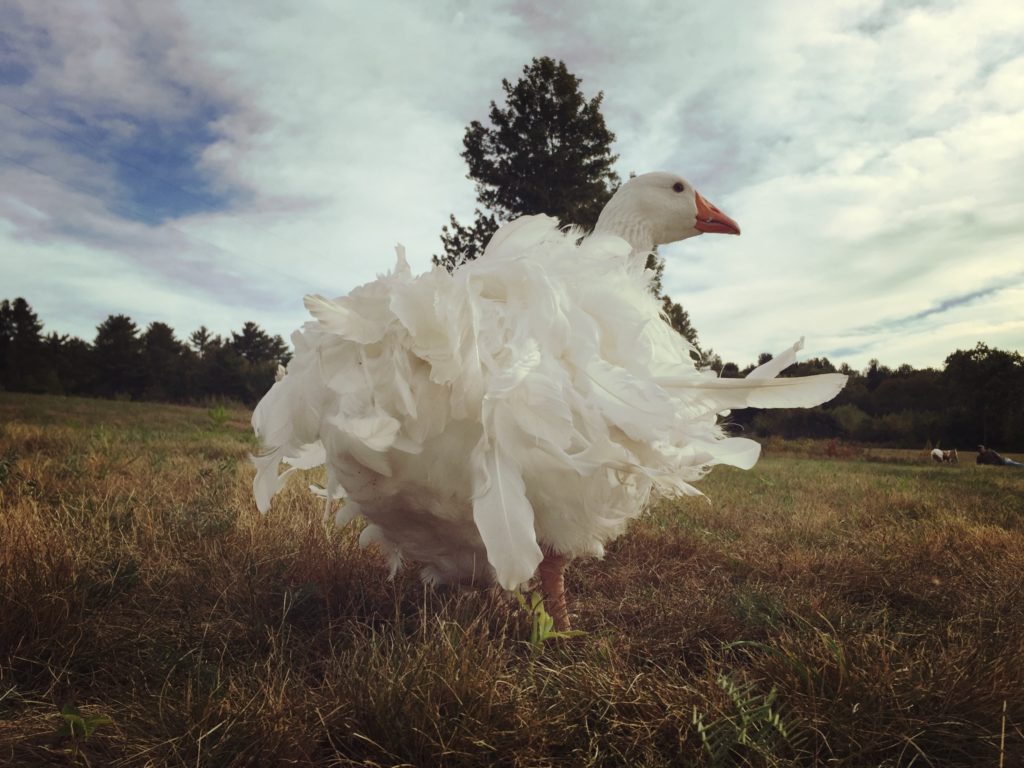
Temperament
Sebastopols are soft-spoken geese, not prone to honking when it isn't necessary. They are shy and pleasant, and rarely aggressive. As average egg layers, female Sebastopols can lay 20-30 eggs in a season, but these birds struggle with low fertility rates. When provided with plenty of deep swimming water in which to breed, a pair can be successful at hatching a clutch of fuzzy offspring.
Thanks to their kind temperaments and spectacular feathers, Sebastopols are a family farm favorite. They are gentle with children, especially when raised by hand, relatively quiet and sure to draw neighborly compliments on their remarkable feathers.
Pilgrim Geese
History
Pilgrim geese, which likely descended from a variety of farmyard mix goslings, are prized for their unusual auto-sexing feathers which allow young male and female birds to be easily distinguished. A few European breeds also have this feature.
While Pilgrim geese get their name from a myth that they were brought to north America by the first European settlers, in fact this goose was cultivated by Midwestern farmers during the Great Depression and finally won admittance to the American Poultry Association's Standard of Perfection in 1939. Oscar Grow, a waterfowl breeder in the 1930s, claims to be the first established breeder of Pilgrim geese and named them for his wife's family's frontier journey.
These geese are also raised in Australia where they are sometimes known as Settlers geese.
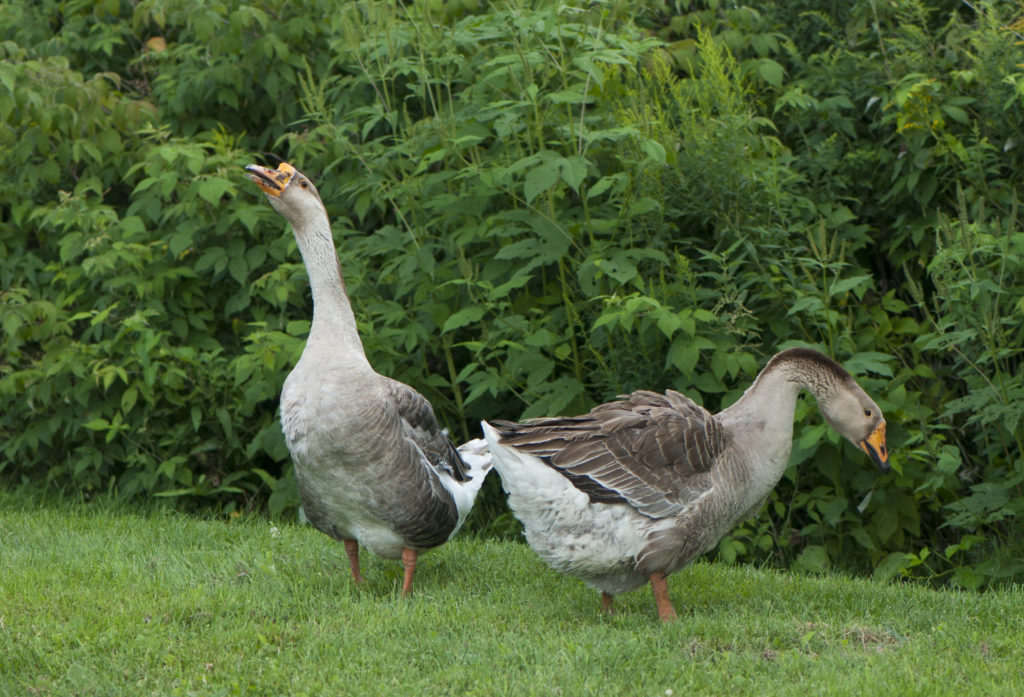
Pilgrim geese
Appearance
Male and female Pilgrim geese have singularly different feathers. Male goslings are yellow with some gray tinting and pink bills and feet. They grow into white or piebald adults with orange beaks and feathers. Females are hatched mostly gray with gray beaks and feathers. As they mature, they become almost solid gray with some white feathering on their underbellies.
Temperament
Pilgrims are even-tempered, not prone to big displays of aggression. Males can b e protective, so it is important to hand raise them if you want a docile bird. They are not loud individuals, but a flock can cause quite a cacophony. Developed our of a need for a goose that could do everything for the destitute farmers of the 1920s and 30s, Pilgrims are versatile backyard birds and sweet-tempered enough to serve as family pets.
Embden Geese
History
Developed in the early 1800s, Embden geese trace their heritage and name to Northern Germany. By 1820, the breed was imported to America and soon admitted to the Standard of Perfection in 1874. A large, full-bodied goose, Embdens were bred primarily for the dinner table and prized for their fast rate of growth. Above average egg layers, they became popular alongside Pilgrim geese as an all-around bird perfect for the family farm.
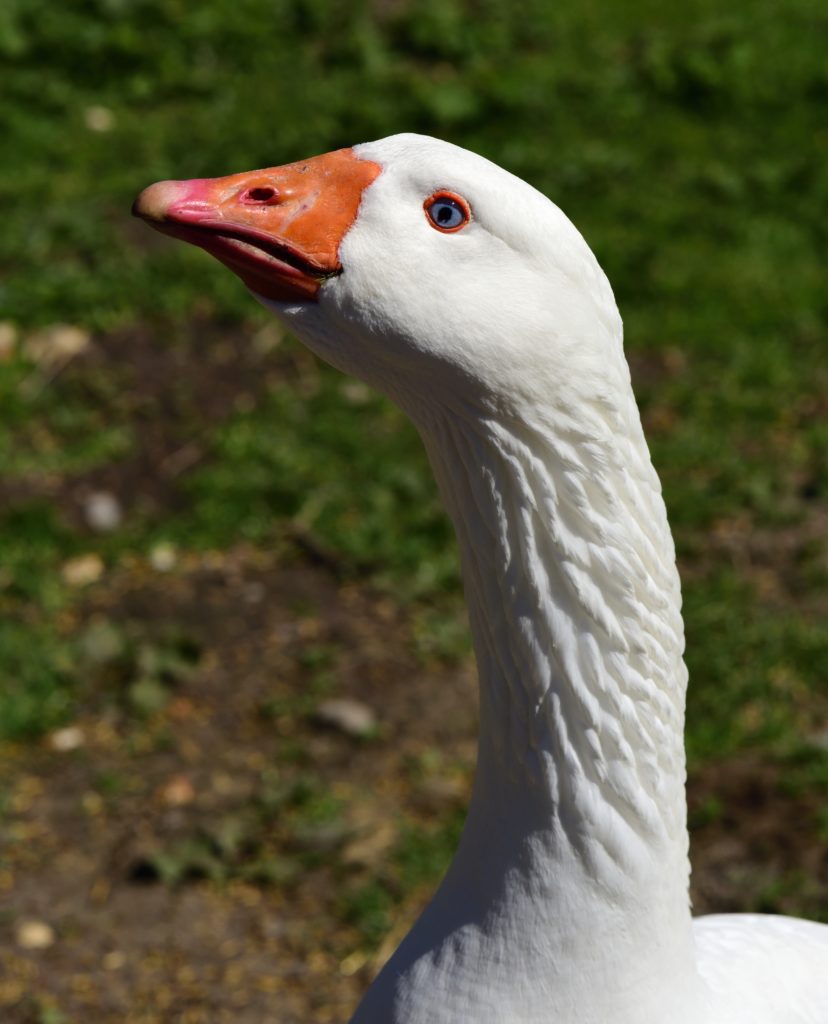
Embden goose in closeup
Appearance
Embden geese stand tall with rounded bodies and full abdomens, their girth accentuated by their short necks, legs, and tails. Solid-bodied, displaying snowy-white feathering with orange beaks and feet, they have steely blue eyes. They are the second-largest breed, behind only the Dewlap Toulouse; adult males can weigh up to 30 pounds.
Temperament
Like many larger breeds, Embdens are fairly laid-back and even-tempered. They are not known for their loud voices, but they are renowned as excellent egg layers and will often go broody to raise their own clutch of goslings. Unlike some breeds, Embdens have no trouble with fertility, and this combined with their parenting instincts makes them one of the more prolific breeds on the modern American farm.
Toulouse, Dewlap, and Production Geese
History
Toulouse geese come in two distinct types, a common production variety and a more unusual, heavy-weight breed known as the Dewlap Toulouse. The Dewlap Toulouse were probably bred originally from moderate-weight geese, but as farmers bred specifically for heavy, visual differences appeared between Production and Dewlap geese.
While production Toulouses were excellent utility birds and a common sight on 19th and early 20th century farms, Dewlaps are much less common. Before they became synonymous withfoie gras, a French delicacy, Dewlaps were already prized for their high fat content at a time when goose fat was valued as a general lubricant. While some farmers raising Dewlap Toulouses specifically forfoie gras kept them caged and force-fed them large quantities of grain, when given access to open pasture, these geese will still put weight quickly, making them an ideal table bird.
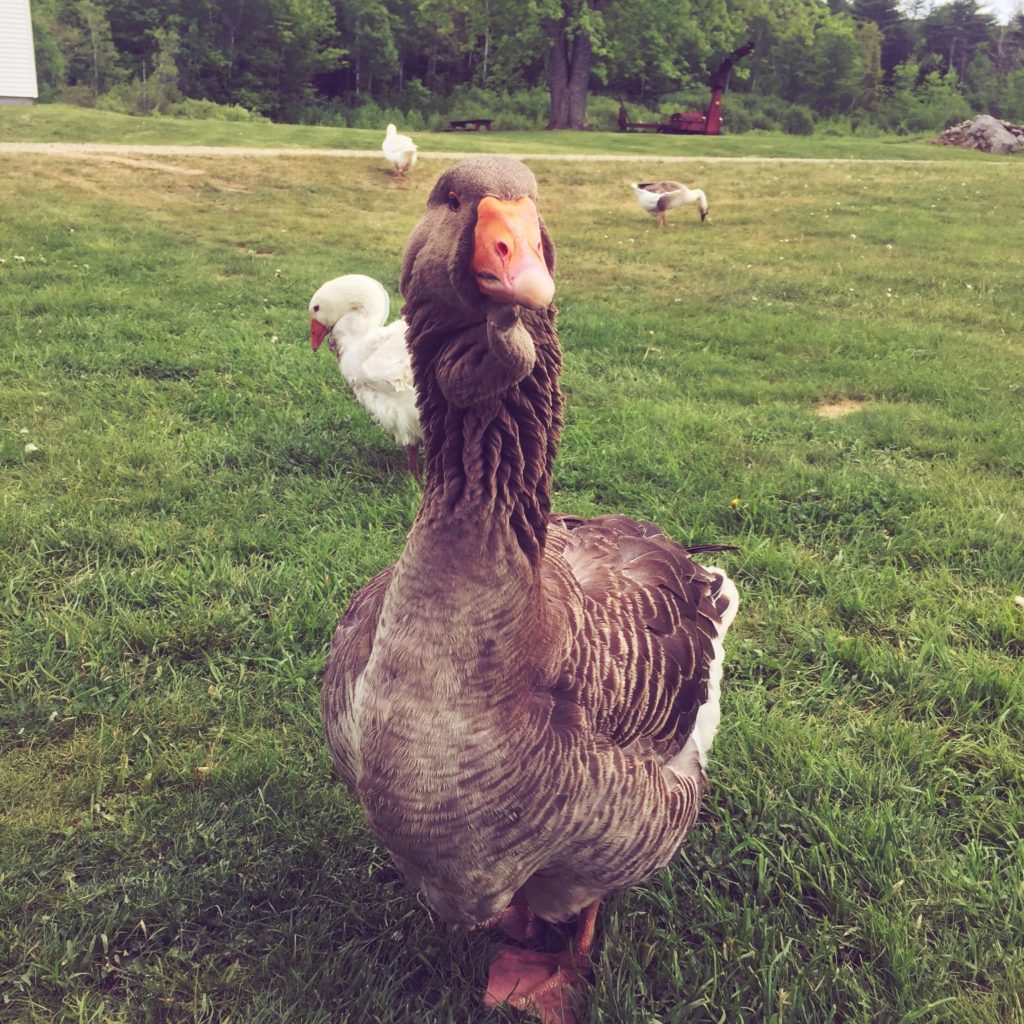
Two-year-old Dewlap Toulouse goose.
Appearance
Production and Dewlap Toulouses have similar gray feathers, with white undersides and orange legs and bills. The former have elegantly curved, smooth necks and tight abdomens, making them easily distinguishable from the Dewlap.
Dewlap Toulouses, meanwhile, could never be confused with any other breed of goose. With a deep, full abdomen, they will develop full lobes (the fleshy area between the legs) that often drag on the ground. Their keels are heavy and round. Adults develop their namesake dewlap, a full paunch of heavy skin hanging beneath their stately beaks.
Adult Dewlap Toulouses can weigh upwards of 30 pounds, while production birds rarely top 20. Both are moderate layers, but Dewlaps lay eggs to match their massive girth, often considerably larger than other goose eggs.
Temperament
Production Toulouses have become common in farmyards. These birds can be aggressive if not handled regularly. Because of their well-established presence across the U.S., it is easy to find them or a bird that traces its heritage to them.
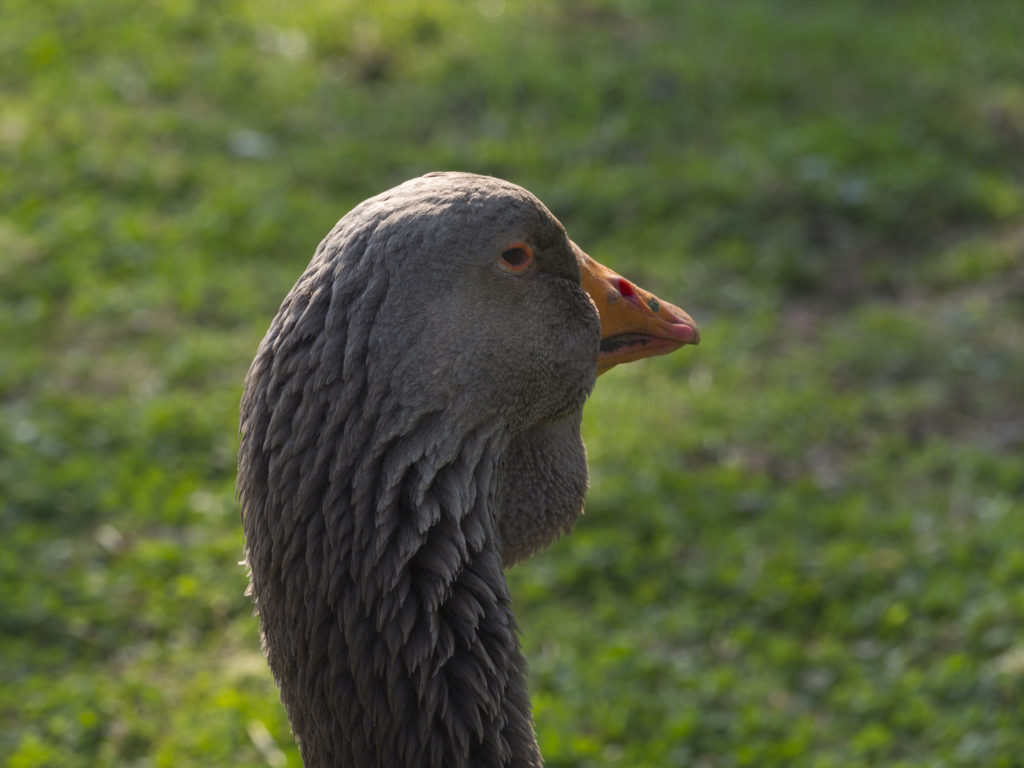
Standard Dewlap Toulouse geese
Dewlap Toulouses, however, seem to feel that food is more important than attitude. These mostly gentle giants have a placid disposition and will always be the first ones at the food trough when grain is offered. While their size and rarity might indicate that they are an exclusively special-purpose bird for meat production, they also seem to make excellent pets. They are not overly vocal, though when they do honk, it can be deafening. Their Mother Goose appearance is charming, but is it their laissez-faire temperament that will win over any farmer.
Excerpted fromThe Modern Homesteader's Guide to Keeping Geeseby Kirsten Lie-Nielsen. Used with permission of New Society Publishers.
Pictures of Different Breeds of Geese
Source: https://www.communitychickens.com/breeds-of-geese-ze01901ztil/